


Framed or unframed, desk size to sofa size, printed by us in Arizona and Alabama since 2007. Explore now.
Shorpy is funded by you. Patreon contributors get an ad-free experience.
Learn more.

- Baldwin 62303
- Baldwin VO-1000
- Cold
- No expense spared
- Tough Guys
- Lost in Toyland
- And without gloves
- If I were a blindfolded time traveler
- Smoke Consumer Also Cooks
- Oh that stove!
- Possibly still there?
- What?!?
- $100 Reward
- Freeze Frame
- Texas Flyer wanted
- Just a Year Too Soon
- WWII -- Replacing men with women at the railroad crossing.
- Yes, Icing
- You kids drive me nuts!
- NOT An Easy Job
- I wonder
- Just add window boxes
- Icing Platform?
- Indiana Harbor Belt abides
- Freezing haze
- Corrections (for those who care)
- C&NW at Nelson
- Fallen Flags
- A dangerous job made worse
- Water Stop
Print Emporium
Where's the Fire: 1914
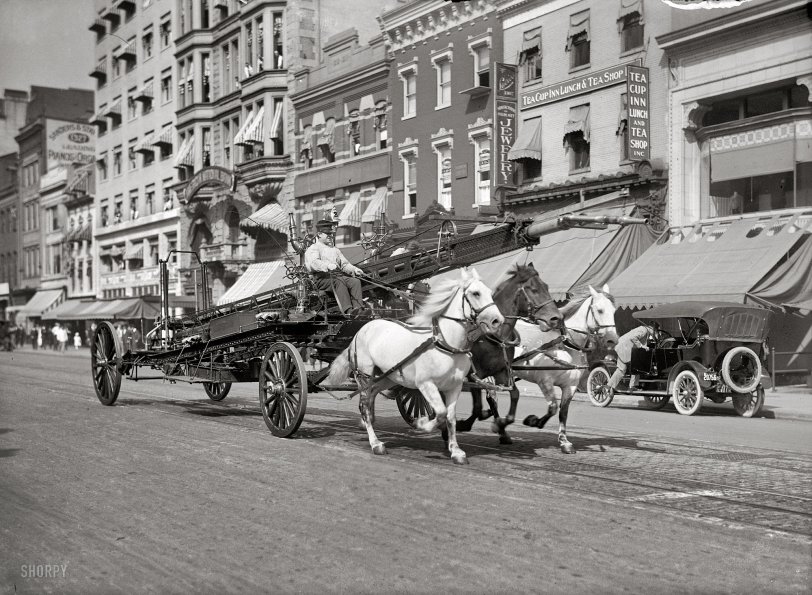
Washington, D.C., circa 1914. "Three-horse team pulling water tower." A fire truck racing past the Tea Cup Inn on F Street. Harris & Ewing. View full size.
Answer to "Standing By"
The horses would be in their stalls until the "gong" went off. Then (very quickly) they'd go in position and waited to be hitched. Don't get in their way.
Horses Respond to Alarm
This 1903 film clip shows firemen and horses responding to the alarm. In a matter of seconds they were off and running.
DCFD Water Tower
This water tower (and the motorized ones to follow) was assigned at Truck C (later Truck 3). Truck C personnel manned the water tower, however Truck C used a regular aerial ladder which responded to everyday calls. In 1971 the department purchased a Sutphen 85-foot Aerial Tower and at first placed it at Truck 3 as a separate unit, however there were no funds to man it separately so it replaced the aerial ladder truck and Truck 3 was known as the aerial tower. It later transferred to Truck 10. Around 1989 the designation of the two Grumman 102-foot aerial platforms was changed from Truck Company 8 and 10 to Tower 8 and 10. Truck 3 now operates with a Seagrave 95-foot aerial tower as Tower 3.
Champion Water Tower
This photo leads to a few cross-references at Shorpy. First, this block of F street is also seen in the far end of the 1924 photo Tales of the City. Second, the truck belongs to Company C, whose station replaced the Donald Hotel in 1932.
Following on from the information provided by the Anonymous Tipster, the apparatus pictured appears to be a Champion Water Tower, manufactured in Chicago by the Fire Extinguisher Manufacturing Company.
Engine Company 16 has an excellent website with some history of Tower #3 including photos. There are two photos of this water tower (one showing full extension) but they are embedded in a slide show so you have to go to the site to see them.
Update: Screen capture from previously mentioned website of the Champion Water Tower in its extended state: I am duly impressed with the height this apparatus can achieve when erect.
New Fire Fighting Machines
Truck Company C, located at Ohio avenue and Fourteenth street northwest, is to be strengthened by the addition of a water tower, which is to be placed in the house. Seven thousand fire hundred dollars was authorized by the current District appropriation bill for the purchase of this modern piece of fire-fighting apparatus, although, through the personal efforts of Commissioner Macfarland, it was secured at a lower price. It is now being built in Chicago, and will be of immense assistance in extinguishing blazes in the business portion of the town.
Washington Post, Nov 7, 1900
Truck Company 3
On April 15, 1901, a water tower truck was purchased from the Fire Extinguisher Manufacturing Company and placed in service at Truck Company C. In 1906 the District of Columbia Fired Department redesignated its truck companies numerically, and Truck Company C became Truck Company 3.
This water tower had an extension height of 75 feet, two support turrets and 12 water inlets. For safety, the horses were to be driven "in a slow trot" when responding to a first or second alarm. When responding to three or more alarms, the driver was authorized to proceed at a gallop.
The DCFD purchased three water towers between 1901 and 1932, but the city never had more that one in service at a time.
Truck Company 3 opened as Truck Company C in 1891 at 14th Street and Ohio Avenue NW, and was housed with Chemical Company No. 1. Truck Company 3 moved to its current [1971] location at 1018 13th Street NW in 1932 and shares quarters with Engine Company 16.
Source: "100 Years of Glory: A History of the District of Columbia Fire Department" (1971).
Where is the 4th guy?
Can someone point out the 4th guy? And what is that guy doing - the one who is bent down behind the tower?? Is that his arm I see reaching for something under/behind the tower? It is hard to tell because the reins are in the way.
[The guy on the right is two guys (two heads, three legs). Reaching for some sort of bag under his boot. - Dave]

Horseshoes
They very likely had a pad between the shoe and hoof to absorb the concussion.
Horseshoes
I wonder how they shod these horses. As a longtime horse person, I know that trotting, cantering or whatever gait you choose on pavement will lame a horse in short order. They must have stuck some kind of shoe on the horse with the hope of leg longevity. Any ideas out there??
[They used horseshoes. - Dave]
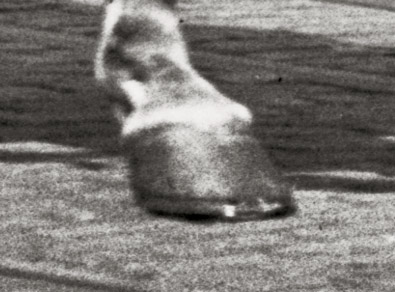
Amazing Apparatus!
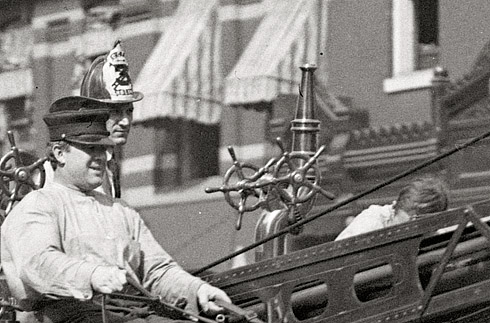
[Note that there are four men aboard, one wearing a helmet. There are two more helmets on the floorboard next to the bell. - Dave]
======================================================
As noted, this is indeed a truck – the original term denoting the larger capacity wagons adapted to carry heavy firefighting equipment. That's also why there's only a driver/operator aboard, as extra men mean extra weight, and towers didn’t require a crew. [See photo above. There are four men on this rig. - Dave] As he isn't wearing turnout gear (helmet, coat, boots etc.) and none are visible, I suspect he's exercising the team. The water tower was a very specialized piece of apparatus, basically an elevating deluge gun used to direct a stream of water into the upper windows of tall buildings. As such, it would only respond to specific locations, or as a second alarm company when the situation warranted. Thus the horses would need to be exercised more often than those of an engine or ladder company.
Each horse had an "assigned" point in the hitch; there wasn't time to sort them out when an alarm sounded, and they were usually chosen for their spot based on temperament and intelligence (fire horses often learned and would go directly to the exact location of the alarm boxes in their response area, based on the bell signals). Some are good leaders, others better wheelers etc. In the horse-drawn era, they were stabled at the rear of the apparatus floor. One of the advances of this age was a system that connected the stable doors and collars to the station's alarm system. When the alarm bells sounded (these were electrical/telegraph systems) the doors opened, each horse ran to his/her spot and slipped into his/her collar. In a matter of minutes, the rig was harnessed and moving.
As for a Dalmatian, it's more likely they'd be with an engine company. Odds are there's a big brass striker gong on the footboard behind the team to clear traffic.
1, 2, 3, 4
There are four men on the fire wagon, not three, you need to look real close.
1, 2, 3
Check again - I count three men on the wagon.
Not top speed
It should be noted that these horses were NOT running at top speed. The two outside greys are trotting. Only the center darker horse is cantering. This (and perhaps that there is only one man on the wagon) suggests they weren't answering a real fire call.
[How do we know they're not returning from one? In any case the team would have to slow down to take a corner or for any of a zillion other reasons. - Dave]
Yo-ho, yo-ho, a Fireman's life for me. . .
I've never specifically studied the history of firefighting, but details from this truck just jumped out at me today. The brass (?) handles for the water spouts have a decidedly nautical feel to them. Also, does anyone know if horses were trained to be in a certain configuration in the harness, or could the black one have just as easily been on one side or the other? I know it looks nice and symmetrical for the photo, but in a hurry could the horses be hooked up in any order?
Where's the Dalmation?
Dalmations were bred to run in front or alongside these teams to clear the way. My Dalmation thought he was doing just that whenever he escaped.
[Fun Fact: The breed is from Dalmatia. Which is why the dogs are called Dalmatians. Not "Dalmations." - Dave]
Please?
Can I please go to the Tea Cup Inn for lunch today? I will only take me 6-8 hours by plane from Arizona...
So much to see
This is one of my favorites! The fast moving horses, manes flowing, the awesome looking old timey fire wagon, the guy getting into his car and the Tea Cup Inn, nicely framed. This is a picture I'd buy and frame.
Anonymous has a good point. This might have been staged. I imagine cameras of the era weren't simple to set up to catch an impromptu scene like this. Unless the photographer was lucky, of course.
Standing By
Wondering if those horses got hitched to this wagon and wait all day or the call comes in, they hitch the horses?
Those horses were smart, too.
The fire department in the small city in Quebec where I grew up had horse-drawn fire apparatus until 1939. The stable was a little way away, down a steep hill. Dad told me the horses were trained so that when the siren sounded to summon the volunteer firemen, the stablehand released the horses and they dashed up the hill to the station and backed into the station between the braces -- or is the word "traces"? -- all on their own.
The city bought two Dodge fire trucks in 1939. The paper mill, further down that steep hill, bought the horses for general haulage work within the mill grounds. Whenever the fire siren sounded the horses bolted, and even when they were pulling a loaded wagon they dashed up the hill and . . . you guessed it . . . backed the wagons into the fire station!
Those 1939 Dodges lasted into sometime in the mid- or late 1960s. I often wonder what happened to the trucks, because the trucks would have been in near-mint condition.
Viewing Figures
This seems to have brought a lot of people to their windows. I wonder if it wasn't the first time they'd galloped past the camera. The driver seems to be enjoying himself too.
























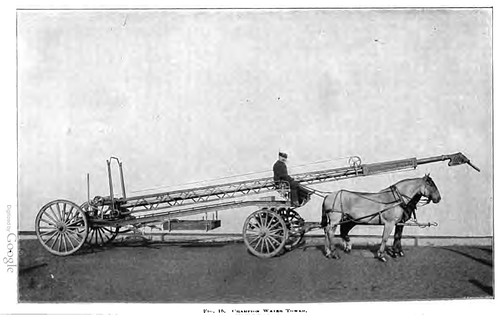
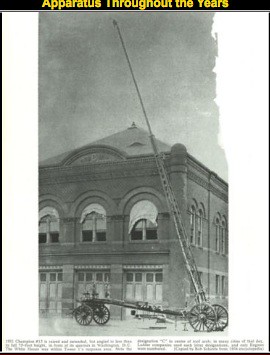
On Shorpy:
Today’s Top 5